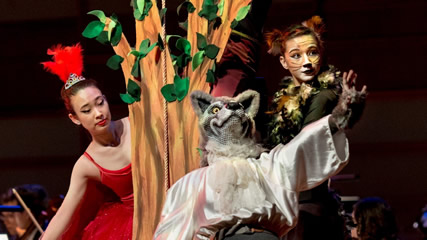Although the title of the closing event of the weeklong Magnolia Baroque Festival was “The Triumph of Love,” it could have just as easily been “The Triumph of Dance.” In the pit were crack early music pros, playing like a dream under the sensitive and swaying leadership of Joseph Gascho, who also served as harpsichordist for the ensemble.
On the stage of the Stevens Center were selections/scenes from two of Henry Purcell’s masques, or as Michael Dodds’ informative program notes calls them, semi-operas: King Arthur (1691) and The Fairy Queen (1692). As founder and director Glenn Siebert explained before the music began, the intent — then and now — is entertainment, like a variety show. And so it was.
Each opera began with an instrumental overture, which immediately took the listener back to merry old England during the days of the Restoration. What is so striking about this seldom-heard music is how dance rhythms permeate the score. It is truly an international style that incorporates rondeau and chaconne from France, florid arias from Italy, and hornpipes and songs from England. Period instruments (instruments either built during the time of the Restoration or constructed to approximate actual instruments) added an authenticity and a sound unlike modern orchestras. There is a subtleness, flexibility, and a sense of improvisation that makes the music breathe.
Sopranos Ah Hong and Cecilia Leitner, tenor Glenn Siebert, and bass Andrew Wentzel sang the main characters in each opera. An understandable plot and character development are definitely not important elements in these works. And that is a good thing, too, since the words were almost impossible to discern. But no matter. The minimal action and presentation of the singers made up for this loss.
Hong sang with a beautiful timbre, with an evenness from the bottom to the top of her range, and her solo singing in such songs as “Hush no more” was a delight to hear. Leitner was at her best in the fast moving pieces, such as “Sing while we trip it.” Siebert’s voice is well known to area audience members, and although he only had a couple of solos, his clear tenor added variety to the proceedings. A rich, lyric sound emanated from Wentzel, especially prominent in the lower register.
The rhythm of dance infused the vocal works as well as the instrumental portions, with the lyrics tripping out of the singers’ mouths. Ensemble between pit and singers was quite good. For the record, not everything was perfect, the most notable being problems with intonation for all of the soloists.
The onstage chorus, like the soloists, was clad in black bottoms and white tops. This group added a great deal to the simple staging — sometimes commenting on the actions taking place or interacting with the main characters. Occasionally members of the group served as soloists to good effect.
The stars of the show, though, had to be the dancers, who gave the entire proceedings a brilliant presence. They contrasted sharply and effectively with others on stage, for they were fully and colorfully costumed. Principals Paige Whitley-Bauguess and Thomas Baird not only danced the lion’s share of the pieces, they also served as the choreographers.
Sometimes the dances took place while there was singing on the stage; other times they were performed without vocal background. Always precise, and elegant when fitting, the members of the New Bern Dancing Assembly displayed remarkable discipline. What a treat!
Bravo to everyone who took part in this successful undertaking to make the Baroque period alive to 21st century audiences through performances of music, drama, and dance. We look forward to 2010 when the Magnolia Baroque Festival returns to the Triad.











